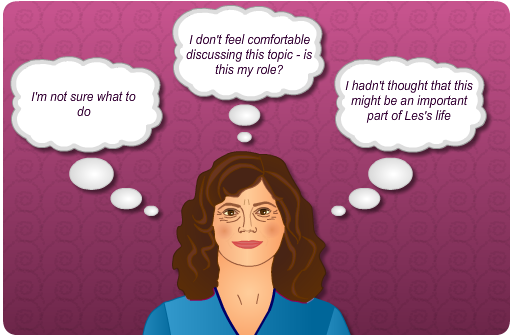
One model which can be easily applied to assessing and discussing sexuality in health care settings is the PLISSIT model.
| The PLISSIT Model | |
|---|---|
| Level | Description |
| Permission The practitioner brings up the topic of sexuality, thereby validating sexuality as a legitimate health issue and giving the client permission to discuss sexual concerns now and later in the programme. |
Most clients need permission to raise their sexual concerns. Although professionals may lack the confidence to discuss sexuality with their clients, the majority of them have adequate knowledge and skills to provide this level of service. |
| Limited Information The practitioner addresses specific sexual concerns and attempts to correct myths and misinformation. |
Much of a health professional’s knowledge and training can be applied to sexuality. At this level, the practitioner’s primary role is that of an educator and therefore should focus on basic sexual information applicable to their area of practice. Many clients would benefit from this level of intervention. |
| Specific Suggestions The practitioner compiles a sexual history with the client to:
|
Fewer clients require this level of intervention, and fewer practitioners are qualified to provide this degree of service. The practitioner should possess counselling skills as well as appropriate information and treatment skills in order to provide treatment at this level. |
| Intensive Therapy The practitioner completes a full assessment of the clients sexual difficulties and formulates a treatment plan. |
This level requires specialist skills of a Psychologist, specialist counsellor or therapist specialising in sexual difficulties. |
| Ref: Adapted from Esmail S, Esmail Y, Munro B. Sexuality and disability: the role of health professionals in providing options and alternatives for couples. Sex disabil. Winter 2001; 19(4):276 | |
Health professionals should:
- be aware that sexuality may be an important part of people’s lives and that they may be asked about sexual concerns
- be comfortable initiating discussion about sexuality at a basic level
- know where to get additional information/support for the individual if required
- be aware that evidence highlights 30% of people want information but only 8.2% received some (Prior et al 2019)
The therapist has used the ‘P’ part of the PLISSIT model as she has given Les permission to speak about and raise his concerns regarding sexual concerns.
We will now take each part of the PLISSIT model and explain/demonstrate how this can be used in practice.
Page last reviewed: 10 Feb 2021


